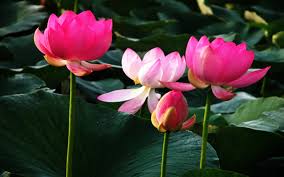Uses of Lotus Flowers
Uses
The distinctive dried seed heads, which resemble the spouts of watering cans, are widely sold throughout the world for decorative purposes and for dried flower arranging.
The flowers, seeds, young leaves, and "roots" (rhizomes) are all edible. In Asia, the petals are sometimes used for garnish, while the large leaves are used as a wrap for food, not frequently eaten (for example, as a wrapper for zongzi). In Korea, the leaves and petals are used as a tisane. Yeonkkotcha is made with dried petals of white lotus and yeonipcha is made with the leaves. Young lotus stems are used as a salad ingredient in Vietnamese cuisine. The rhizome (called ǒu (藕) in pinyin Chinese, ngau in Cantonese, kamal kakri in Hindi, renkon (in Japanese), yeongeun (연근 in Korean) is used as a vegetable in soups, deep-fried, stir-fried, and braised dishes and the roots are also used in traditional Asian herbal medicine. Petals, leaves, and rhizome can also all be eaten raw, but there is a risk of parasite transmission (e.g., Fasciolopsis buski): it is therefore recommended that they be cooked before eating.
Lotus rootlets are often pickled with rice vinegar, sugar, chili and/or garlic. It has a crunchy texture with sweet-tangy flavours. In Asian cuisine, it is popular with salad, prawns, sesame oil and/or coriander leaves. Lotus roots have been found to be rich in dietary fiber, vitamin C, potassium, thiamin, riboflavin, vitamin B6, phosphorus, copper, and manganese, while very low in saturated fat.[citation needed]
The stamens can be dried and made into a fragrant herbal tea called liánhuā cha in Chinese, or (particularly in Vietnam) used to impart a scent to tea leaves. This Vietnamese lotus tea is called trà sen, chè sen, or chè ướp sen. The lotus seeds or nuts (called liánzĭ,or xiān liánzĭ, in Chinese) are quite versatile, and can be eaten raw or dried and popped like popcorn, phool makhana. They can also be boiled until soft and made into a paste, or boiled with dried longans and rock sugar to make a tong sui (sweet soup). Combined with sugar, lotus seed paste becomes one of the most common ingredients used in pastries such as mooncakes, daifuku, and rice flour pudding.
In Vietnam, the bitter tasting germs of the lotus seeds are also made into a tisane (trà tim sen).
A unique fabric from the lotus plant fibers is produced only at Inle lake, Union of Myanmar and is used for weaving special robes for Buddha images called kya thingahn (lotus robe).










Lotus root, cooked, no salt
Nutritional value per 100 g (3.5 oz)
Energy 278 kJ (66 kcal)
Carbohydrates 16.02 g
Sugars 0.5 g
Dietary fiber 3.1 g
Fat 0.07 g
Protein 1.58 g
Water 81.42 g
Thiamine (vit. B1) 0.127 mg (11%)
Riboflavin (vit. B2) 0.01 mg (1%)
Niacin (vit. B3) 0.3 mg (2%)
Pantothenic acid (B5) 0.302 mg (6%)
Vitamin B6 0.218 mg (17%)
Folate (vit. B9) 8 μg (2%)
Choline 25.4 mg (5%)
Vitamin C 27.4 mg (33%)
Calcium 26 mg (3%)
Iron 0.9 mg (7%)
Magnesium 22 mg (6%)
Manganese 0.22 mg (10%)
Phosphorus 78 mg (11%)
Potassium 363 mg (8%)
Sodium 45 mg (3%)
Zinc 0.33 mg (3%)

No comments:
Post a Comment